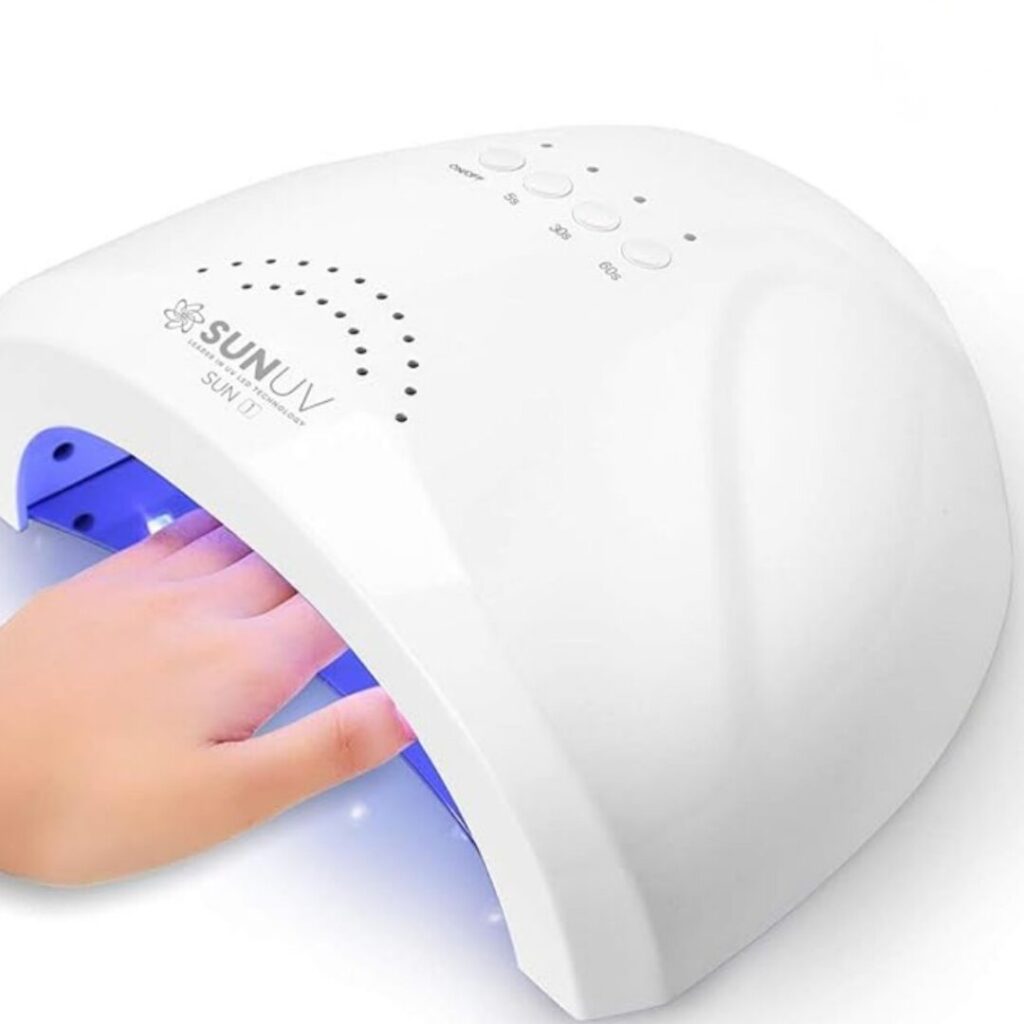Why LED Lamps Are the New Industry Standard
LED (Light Emitting Diode) lamps have become the go-to in the nail industry for good reason. They cure gels faster, use less power, and last longer than traditional fluorescent UV lamps. LED lamps emit a narrower UV-A wavelength band that’s optimized for curing gel nails, which means less waste heat and less time sitting under the light. Because the spectrum is narrower and more focused, the energy is used more efficiently.
Traditional UV lamps use fluorescent tubes that emit a broader spectrum of UV light and often take longer (30–60 seconds or more) per layer. LED lamps, by contrast, often cure in 10–30 seconds per layer (depending on the lamp and gel formula).
Because of these performance advantages — speed, efficiency, longevity, and lower heat — LED curing has become the industry standard among professional nail techs.
Safety & Myth Busting: Are LED / UV Lamps Dangerous?
One of the most common fears is that nail lamps are like tanning beds — a concern about UV exposure and cancer risk. But in reality, the wavelengths and intensities used in nail curing lamps are very different.
Doug Schoon, a respected chemist in the nail industry, has published work dispelling many myths around nail lamps. In his article “Are UV/LED Lamps Safe?”, Schoon states that these lamps emit only UV-A (the safer portion of UV light), and they filter out harmful UV-B and UV-C wavelengths. Creata Beauty
He cites scientific studies showing that, when used properly, UV nail lamps are at least three times safer than direct sunlight and eleven times safer than ambient mid-angle sunlight. Creata Beauty+1
In another white paper, Schoon and colleagues measured nail lamps against natural sunlight and found that the UV-B output in the nail lamp was less than that of the sun. Schoon Scientific They also showed that to match the UV exposure from a nail lamp, a person would need to sit under it for extremely long durations — far more than what a typical manicure requires. RadTech
Regulatory bodies like the FDA have also weighed in. In a commentary, the FDA referred to UV nail lamps as low risk when used as directed. RadTech Magazine They emphasized that many lamp outputs fall well below occupational UV exposure limits.
Still, as with any tool, safe use matters. Here are tips to minimize any risk:
- Only use lamps as instructed (timers, correct distance, recommended cure times).
- Avoid using lamps for unnecessary durations.
- If clients request, they may use a thin layer of broad-spectrum sunscreen (on the back of their hand) or wear protective gloves with the fingertips cut off (though this must be done carefully so it doesn’t interfere with curing).
- Replace bulbs or lamps when their output decreases or after the recommended lifespan.
Overall, the scientific consensus is that LED / UV nail lamps do not pose a significant cancer risk when used properly and that the nail-cure exposure is far less than daily sun exposure.
What to Look for in an Affordable Yet Reliable Lamp
Here are features and specs that help you find a lamp that’s “good, not expensive, but still professional enough”:
| Feature | Ideal Spec / Info |
|---|---|
| Wavelength Range | Usually 365–405 nm (some lamps also list 395–405 nm). Avoid lamps that include UV-C or broad spectrum. |
| Timer Settings & Modes | Multiple presets (e.g. 10s, 30s, 60s, “low heat”) help you adapt for different gels. |
| Sensor / Auto On-Off | Automatically turns on when hand is inserted, turns off when removed — convenient and safer. |
| Power / Wattage | Higher wattage doesn’t always mean safer — more important is irradiance (mW/cm²). But many solid beginner/pro models range from 24W to 54W. |
| Design & Size | Enough space to fit a full hand; detachable bases for pedicures; reflective interior surfaces help even cure. |
| Cooling / Heat Management | Lamps with vents or low-heat modes help avoid discomfort or overheating. |
| Durability | LEDs last long, but the lamp unit, shell, and electronics should be solid. Check reviews for durability. |
| Replacement / Warranty | Some brands offer warranties or replaceable parts. |
A lamp doesn’t need to cost $200 to be good. You can get a solid, reliable LED lamp under $50 (or even under $30) that performs well for regular salon or home use — especially if you’re strategic about specs and reviews.
Lamps I Have

